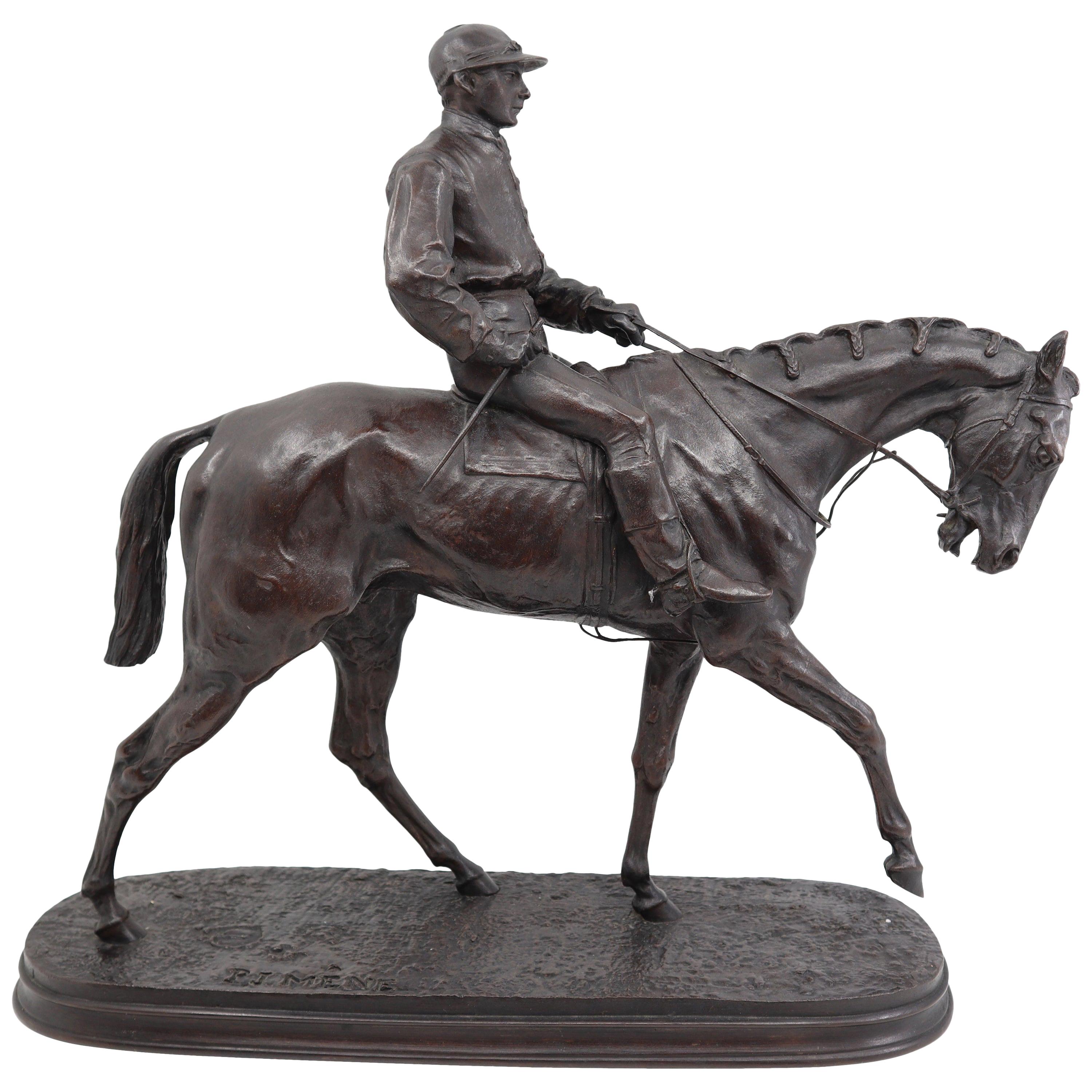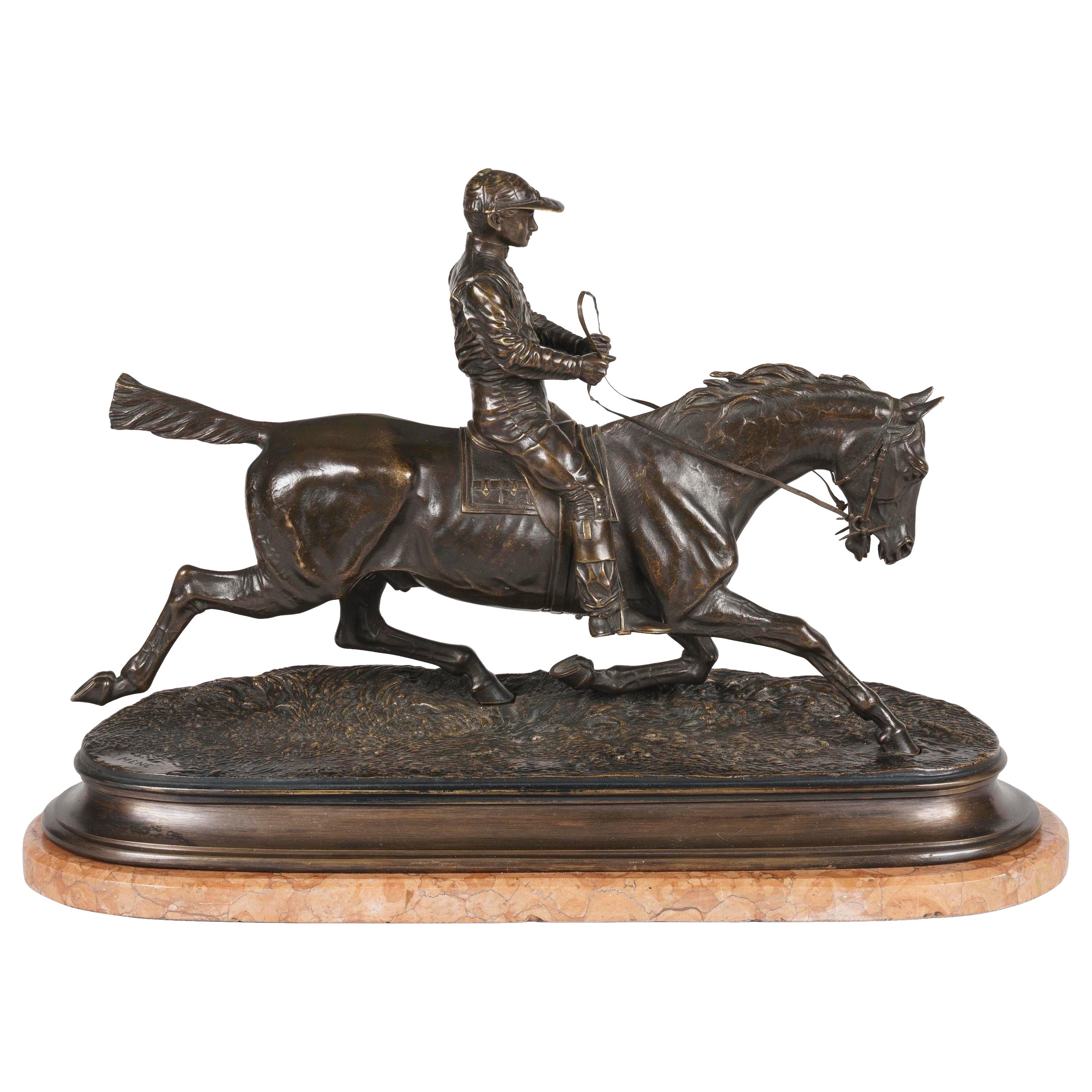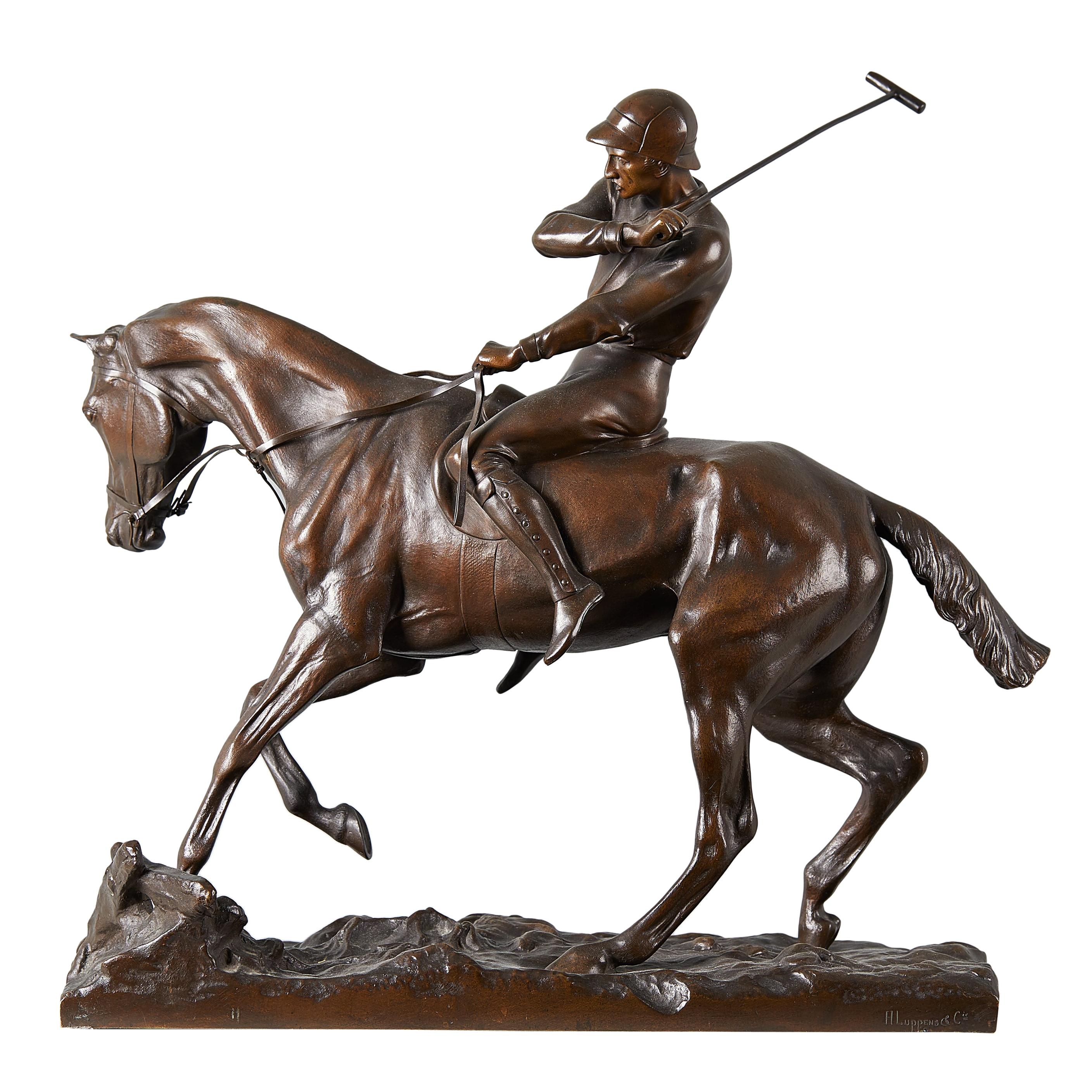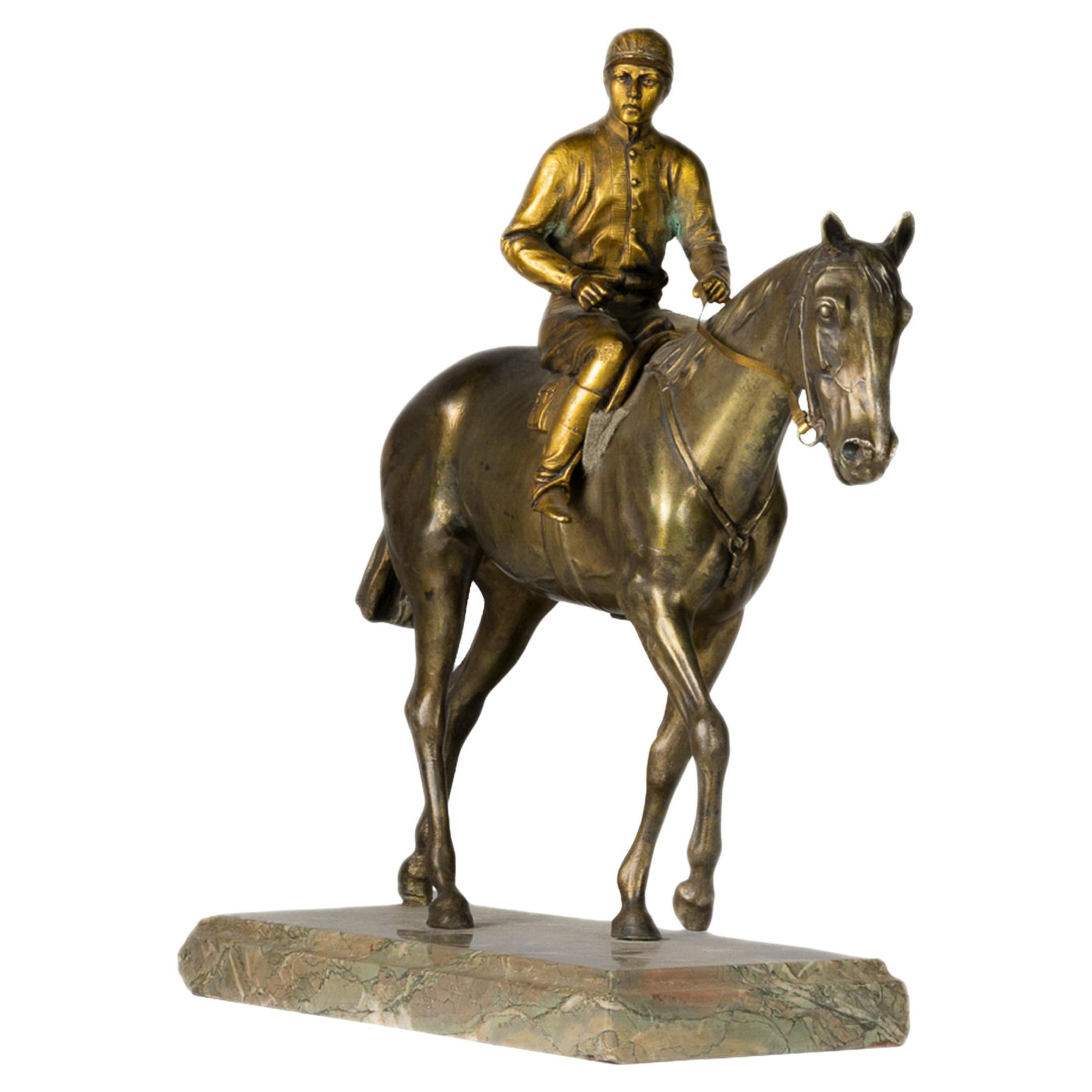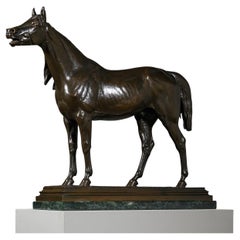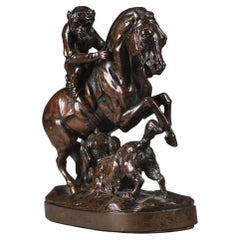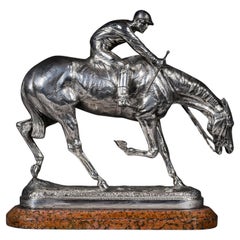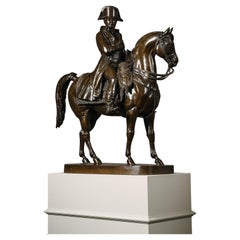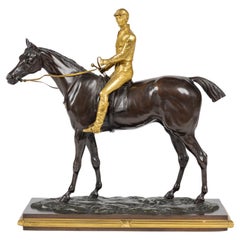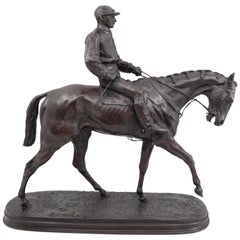Items Similar to ‘Le Grand Jockey ‘I by Sidore Jules Bonheur
Want more images or videos?
Request additional images or videos from the seller
1 of 6
‘Le Grand Jockey ‘I by Sidore Jules Bonheur
$116,485.76
£85,000
€99,166.31
CA$159,556.37
A$177,461.51
CHF 92,664.89
MX$2,159,517.82
NOK 1,183,472
SEK 1,109,887.95
DKK 740,116.14
Shipping
Retrieving quote...The 1stDibs Promise:
Authenticity Guarantee,
Money-Back Guarantee,
24-Hour Cancellation
About the Item
Isidore Jules Bonheur (French, 1827-1901)
‘Le Grand Jockey ‘
Signed 'I Bonheur' and with foundry stamp PEYROL EDITEUR'.
Bronze, rich mid-brown patina.
The name Isidore-Jules Bonheur is synonymous with the great animalier school of sculptors of the late 19th century. Amongst Bonheur’s wide variety of animal sculptures exhibited at the Salon, there were a number of mounted equestrian models, including three designs of jockeys on horseback shown in 1864, 1879 and 1886. The most famous of these is Le Grand Jockey, of which the present cast is a rare, large, and fine example.
It shows a victorious jockey patting his horse on the neck in congratulation, perfectly chiselled especially with precision work for the veins, tendons and muscles, as well as the rider's jacket and the horse's mane. First exhibited at the 1879 Salon in bronze, under the title ‘Un Jockey’, it was displayed alongside another equestrian group, Un cavalier, époque de Louis XV (nos. 4817 and 4816 respectively). Exhibited again four years later at the Exposition Nationale des Beaux-Arts in 1883 and for the third time at the Universal Exhibition of 1889, where Bonheur received the prestigious Medaille d'Or. Le Grand Jockey was subsequently edited in four different sizes, the present cast being an example of the second largest.
Son of the painter Raymond Bonheur and brother of Rosa Bonheur, Isidore Bonheur was born in 1827 in Bordeaux and trained with his father. He exhibited in 1848 for the first time at the Salon des Artistes Français and entered the School of Fine Arts in Paris where he turned his attention to sculpture.
Bonheur had a close working relationship with his brother-in-law, the celebrated Parisian founder Hippolyte Peyrol, who was married to his sister Juliette (1830-1891). These close ties resulted in the production of exceptionally cast and finely chased bronzes, often identified, as here, by Peyrol's tiny cachet. Peyrol was a master caster and his foundry in Paris is rightly considered one of the finest of the period.
France, Circa 1890.
Literature
S. Lami, ‘Dictionnaire des sculpteurs de l’école française du XIXe siècle’, vol. 1, Paris, 1916, pp.127-130; J. Horswell, ‘Les Animaliers’, Woodbridge, 1971, p. 209; M. Forrest, Art Bronzes, Pennsylvania, 1988, p. 227.
M. Forrest, ‘Art Bronzes’, Pennsylvania, 1988, p. 227.
Pierre Kjellberg, ‘Les Bronzes du XIX e siècle’, Dictionnaire
des Sculpteurs, Paris 1987, l’Amateur Ed. Pages 102 et
103.
Isidore-Jules Bonheur (1827-1901) was the son of the painter Raymond Bonheur and younger brother of Rosa Bonheur, the famous sculptor. He was born in Bordeaux and studied painting, at first with his father and then with the Ecole des Beaux Arts in Paris, moving on to sculpture in 1848.
He made his debut at the Paris Salon in 1848 with a painting and plaster study of the same subject ‘African horseman attacked by a lioness’. From then onwards, Bonheur exhibited regularly at the Salon as well as other exhibitions, winning medals in 1865 and 1869 together with the prized Gold Medal at the Exposition Universelle of 1889.
He was awarded the Legion d’Honneur in 1895.
Most of Bonheur’s casts were by his uncle by marriage, Hippolyte Peyrol, whose tiny foundry mark is often very difficult to find.
Bonheur’s studies range from farm animals, bears and tigers in a very naturalistic vein to equestrian groups. Although noted primarily for his small groups he did complete two large scale commissions, one to his sister Rosa, at Fontainbleau and the other, two stone lions at the steps of the Royal Palais de Justice, Paris. Bonheur became part of the group of animal sculptors of the late nineteenth century known as ‘Les Animaliers’
Working in a realistic manner, Bonheur was an acute observer of nature - his animals were not ‘humanised’ but modelled to catch a pose characteristic of the particular species. He achieved this particularly well with his sculptures of horses, which, usually more relaxed than spirited, are among his most successful works.
Literature
Jane Horswell, Bronze Sculptures of ‘Les Animaliers’ , p201
Pierre Kjellberg, Les Bronzes du XIX Siècle, p101.
- Creator:Isidore Jules Bonheur (Sculptor)
- Dimensions:Height: 24.41 in (62 cm)Width: 29.53 in (75 cm)Depth: 6.3 in (16 cm)
- Materials and Techniques:Bronze,Patinated
- Place of Origin:
- Period:
- Date of Manufacture:circa 1890
- Condition:Wear consistent with age and use.
- Seller Location:Brighton, GB
- Reference Number:Seller: B768701stDibs: LU1028030498032
About the Seller
5.0
Recognized Seller
These prestigious sellers are industry leaders and represent the highest echelon for item quality and design.
Established in 1964
1stDibs seller since 2014
58 sales on 1stDibs
Typical response time: 3 hours
Associations
The British Antique Dealers' AssociationLAPADA - The Association of Arts & Antiques Dealers
- ShippingRetrieving quote...Shipping from: Brighton, United Kingdom
- Return Policy
Authenticity Guarantee
In the unlikely event there’s an issue with an item’s authenticity, contact us within 1 year for a full refund. DetailsMoney-Back Guarantee
If your item is not as described, is damaged in transit, or does not arrive, contact us within 7 days for a full refund. Details24-Hour Cancellation
You have a 24-hour grace period in which to reconsider your purchase, with no questions asked.Vetted Professional Sellers
Our world-class sellers must adhere to strict standards for service and quality, maintaining the integrity of our listings.Price-Match Guarantee
If you find that a seller listed the same item for a lower price elsewhere, we’ll match it.Trusted Global Delivery
Our best-in-class carrier network provides specialized shipping options worldwide, including custom delivery.More From This Seller
View AllPatinated Bronze Statue Of ‘A Horse Calling’, By Isidore-Jules Bonheur
By Isidore Jules Bonheur
Located in Brighton, West Sussex
A Large Patinated Bronze Statue Of ‘A Horse Calling’, By Isidore-Jules Bonheur (French, 1827 – 1901).
Bronze with a dark brown patina, on a veined green marble base.
Signed ‘I. BON...
Category
Antique 19th Century French Animal Sculptures
Materials
Bronze
‘The Monkey Rider’, Paul Joseph Raymond Gayrard
Located in Brighton, West Sussex
‘The Monkey Rider’ – Paul Joseph Raymond Gayrard (1807 - 1855).
Signed to the base ‘Paul Gayrard’ and dated 1846.
A rare patinated bronze group of a monkey in the guise of a Jockey riding a racehorse, startled by a barking dog at his feet.
French, Dated 1846.
The mid-nineteenth century saw a surge of interest in animalier bronzes with whimsical and anthropomorphic subjects becoming particularly fashionable. In a similar vain to Christophe Fratin’s humanised depiction's of Bears posed as lamp lighters, dentists and reading books, Gayrard created his famous Monkey bronzes. He was awarded a First Class Medal at the 1846 Salon for his humorous group ‘The Monkey Steeplechase’, which can be related to subject of the present sculpture, ‘Monkey Rider’.
With the publication of Darwin’s ‘Origin of Species in 1859’ the popularity of anthropomorphically conceived subjects began to decline. As such these sculptures were only created during a very brief window of time and are consequently very rare.
PAul Joseph Ryamond Gayrard
Paul Joseph Raymond Gayrard (1807 – 1855) born in Clermont-Ferrand, France.
He studied at an early age under his father the sculptor and engraver Raymond Gayrard, before becoming a student of François Rude and later David d'Angers.
He first exhibited at the Paris Salon in 1827 and continued to submit works throughout his lifetime winning a Second Class Medal in 1834 and a First Class Medal in 1846 and 1848. His last recorded exhibit was in 1855.
He executed many busts of notables of the day which proved popular with the haute bourgeois, but it was his talent for animalier that confirmed his reputation as a sculptor of considerable talent. His known bronze animal models date from the years 1846 until 1848 with his powerful plaster of a 'Harness Horse...
Category
Antique Mid-19th Century French Animal Sculptures
Materials
Bronze
John Willis-Good, ‘After The Race’, A Silvered Bronze Equestrian Group
By John Willis Good
Located in Brighton, West Sussex
John Willis-Good (British, 1845 - 1879)
‘After The Race’.
A Silvered Bronze Equestrian Group Cast By Elkington & Co, Birmingham.
Depicting a racehorse with jockey up, at the dynam...
Category
Antique 19th Century English Animal Sculptures
Materials
Slate, Bronze
Emperor Napoleon on Horseback, Cast by Susse Frères, Paris
By Susse Freres
Located in Brighton, West Sussex
A Large Patinated Bronze Sculpture of Emperor Napoleon on Horseback, Cast by Susse Frères, Paris, From the Model By Alfred Émilien O'Hara, Comte de Nieuwerkerke (1811-1892).
Dark br...
Category
Antique 19th Century French Napoleon III Figurative Sculptures
Materials
Bronze
A Patinated Bronze Statue Of Teucer, By Sir William Hamo Thornycroft
By William Hamo Thornycroft
Located in Brighton, West Sussex
Sir William Hamo Thornycroft (British, 1850-1925)
A Patinated Bronze Statue Of Teucer
The standing figure of the male nude holding his bow in his outstretched left hand, raised on a...
Category
Antique 19th Century English Neoclassical Figurative Sculptures
Materials
Bronze
Antoine Louis Barye, Bronze Model of 'Elephant De Senegal'
By Antoine-Louis Barye, Ferdinand Barbedienne
Located in Brighton, West Sussex
Antoine-Louis Barye (French, 1795-1875).
‘Éléphant du Sénégal’ (‘Senegalese Elephant’).
Patinated bronze.
Cast by Ferdinand Barbedienne, Paris, from the model by Antoine-Louis B...
Category
Antique 19th Century French Animal Sculptures
Materials
Bronze
You May Also Like
Isidore-Jules Bonheur, A Rare Gilt and Patinated Bronze Jockey on A Horse
By Isidore Jules Bonheur
Located in Queens, NY
Isidore-Jules Bonheur (French, 1827–1901)
A Rare Gilt and Patinated Bronze Jockey on A Horse, circa 1875.
Introducing a truly exceptional and highly s...
Category
Antique 19th Century French Sporting Art Animal Sculptures
Materials
Bronze
$14,850 Sale Price
44% Off
French Bronze Jockey on Horse by Pierre Jules Mêne
By Pierre Jules Mêne
Located in Lantau, HK
A self-taught artist, Piere-Jules Mêne (1810-1879) dedicated his entire career to making bronze statues, which were met with great success among both French and international clients...
Category
Antique 19th Century French Animal Sculptures
Materials
Bronze
Jockey Winner
By Isidore Jules Bonheur
Located in PARIS, FR
Jockey Winner
by Isidore BONHEUR (1827-1901)
A rare and magnificent bronze group with a dark brown patina
Signed on the base "I. Bonheur"
A period cast by "Peyrol" (with the foundry stamp)
Standing on a molded wooden base
France
circa 1880
height of the bronze : 53,5 cm
total height with the base : 62 cm
total length : 68 cm
depth : 24 cm
Biography:
Isidore Jules Bonheur (1827-1901) was a French painter and sculptor. Isidore first received an artistic apprenticeship from his father Raymond and his older sister Rosa, then, in 1827, he entered the School of Fine Arts in Paris. After practicing...
Category
1880s French School Figurative Sculptures
Materials
Bronze
French 19th Century Equestrian Bronze Sculpture after Pierre-Jules Mêne
Located in London, GB
An equestrian sculpture
after Pierre-Jules Mêne
A naturalistic, carefully detailed and beautifully patinated bronze model of a jockey on his galloping horse, the realistic topogr...
Category
Antique 19th Century French Sporting Art Animal Sculptures
Materials
Bronze
Joseph Cuvelier Equestrian Bronze, circa 1860
Located in Petworth, West Sussex
A Joseph Cuvelier (French 1833-1879) bronze equestrian model of a polo player, circa 1860, cast by H. Luppens & Cie, dark brown patina.
Category
Antique Mid-19th Century French Figurative Sculptures
Materials
Bronze
$5,097 Sale Price
20% Off
Gilt & Patinated Bronze Jockey on Horse, Marble Base, 19th Century
Located in Lisbon, PT
A French “Jockey à Cheval” sculpture from the Napoleon III period crafted in gilt and patinated bronze, depicting a jockey and his faithful horse in fine detail. The piece rests on a...
Category
Antique 19th Century French Napoleon III Animal Sculptures
Materials
Marble, Metal, Brass, Bronze
$2,800 Sale Price
20% Off
More Ways To Browse
Royal Palais
Horse Jockey
Jockeys And Horse
Small African Sculpture
Horse And Rider Sculpture
The Paris Salons 1895
19th Century French Bronze Sculpture Lion
Patinated Bronze Bear
Antique Bronze Tiger
Jockey Sculpture
Les Pierre Antiques
Large Bronze Bear Sculpture
Equestrian Jockey
Bronze Jockey
Plaster Horse Sculpture
Lion Lioness
Antique Cavalier Furniture
Horseman Antique

